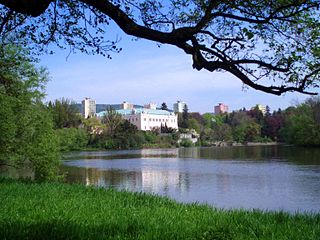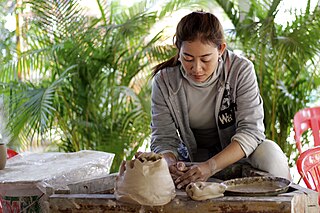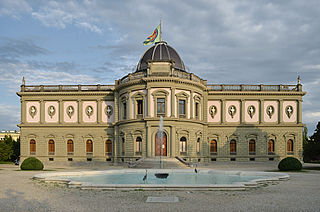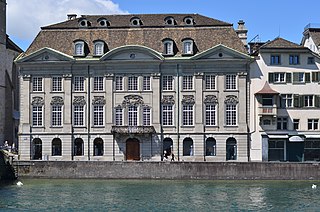 W
WA ceramics museum is a museum wholly or largely devoted to ceramics, usually ceramic art. Its collections may also include glass and enamel, but typically concentrate on pottery, including porcelain. Most national collections are in a more general museum covering all of the arts, or just the decorative arts. However, there are a number of specialized ceramics museums, with some focusing on the ceramics of just one country, region or manufacturer. Others have international collections, which may be centered on ceramics from Europe or East Asia or have a more global emphasis.
 W
WThe Glassware and Ceramic Museum of Iran or simply Abgineh Museum is located at 30 Tir Street, in Tehran, Iran. It was private residence of longtime Prime Minister Ahmad Qavam from 1921 until 1951. The complex was also Embassy of Egypt for seven years.
 W
WThe Applied Arts Collection of Milan is located in the Sforza Castle museum complex under the management of the municipality of Milan, Italy. The museum is divided into several sections with particular emphasis on jewelry, ivories, pottery and art glass.
 W
WThe Argentona Water Jug Museum, founded in 1975, is located in a building which opened on 20 July 2000. The origins of the museum can be found in the Water Jug Festival, which is celebrated on 4 August every year since 1951, upholding a traditional celebration dating back to the 17th century, brought about by a ‘vow of the town' to Saint Dominic, patron saint of water, to protect Argentona from a grave pestilence. Every year, coinciding with the Water Jug Festival, the Water Jug Museum organises the International Ceramic and Pottery Festival, the dates of which vary according to the day on which 4 August falls, in order to disseminate and promote the conservation of traditional pottery and the new values of the ceramics being produced.
 W
WThe Can Tinturé Museum, in Esplugues de Llobregat, is located in a house built at the end of the 19th century by architect Claudi Duran i Ventosa, and is the first monographic sample tile museum in Spain. The Can Tinturé Museum also manages the museum at the Pujol i Bausis factory, La Rajoleta, which was a point of reference in the production of Catalan industrial tiles, especially during the highpoint of Art Nouveau. The Museum is part of the Barcelona Provincial Council Local Museum Network and of the territorial system of the Science and Technology Museum of Catalonia.
 W
WThe Centre for the Study of Traditional Pottery, also known as Psaropoulos Museum of Traditional Pottery and as Study Centre for Contemporary Ceramics is a museum in Athens, Greece. The study centre was established in 1987 to research, preserve and promote the production of traditional Greek ceramics. Since 1999 it has been located in a neo-classical building at 8 Hepitou Street in Plaka and was officially inaugurated on May 18, 2000, International Museum Day.
 W
WThe Museo Regional de la Cerámica in Tlaquepaque, Jalisco, Mexico is located on Independencia Street in the center of the city. The museum is one of two main ceramics museums in the city, with the other being the Pantaleon Panduro Museum. It was established in 1954 to preserve and promote indigenous handcrafts of Jalisco, especially the state’s ceramic tradition. The emphasis is still on ceramics but the museum also has a room dedicated to Huichol art and holds events related to various types of indigenous crafts and culture.
 W
WThe Ceramics Museum of Sacavém is situated in the town of Sacavém in the municipality of Loures, just northeast of Lisbon in Portugal. The museum was opened in July 2000 and was constructed on the grounds of a former ceramics factory. Most of the exhibits reflect the output of that factory and its documentation centre is devoted to the study of the history and production of the factory and the industrial heritage of the municipality. In 2002 the museum was awarded the Luigi Micheletti Prize in the Industrial Heritage category.
 W
WThe Chateau at Klášterec nad Ohří is on the left bank of the Ohře River, in the northwestern part of the historical region of Bohemia. It is in Klášterec nad Ohří of the Ústí nad Labem Region in the Czech Republic. The chateau complex is a prominent landmark in the town's recently restored historic urban conservation area.
 W
WThe Design Museum Den Bosch is a museum for modern art in 's-Hertogenbosch, The Netherlands.
 W
WThe Dresden Porcelain Collection is part of the Staatliche Kunstsammlungen of Dresden, Germany. It is located in the Zwinger Palace.
 W
WSchloss Favorite is a schloss on the outskirts of Rastatt-Förch in Baden-Württemberg, Germany.
 W
WThe Fürstenberg China Factory was founded on 11 January 1747 in Fürstenberg, on the Weser river, by Johann Georg von Langen at the direction of Duke Charles I of Brunswick-Wolfenbüttel. It is the second oldest porcelain manufacturer in Germany that still operates on its original site.
 W
WThe George R. Gardiner Museum of Ceramic Art is a ceramics museum in Toronto, Ontario, Canada. The museum is situated within University of Toronto's St. George campus, in downtown Toronto. The 4,299.2-square-metre (46,276 sq ft) museum building was designed by Keith Wagland, with further expansions and renovations done by KPMB Architects.
 W
WThe National Museum of Ceramics and Decorative Arts "González Martí", located in Valencia, Spain, is a museum dedicated to ceramics, porcelains and other decorative arts such as textile art, traditional costumes and furniture.
 W
WThe Keramik-Museum Berlin is a ceramic art museum in Berlin. It was established in 1990 and is located in a historic building in the Charlottenburg neighborhood since January 2004. Exhibitions feature design classics and works of famous ceramists.
 W
WKhmer Ceramics & Fine Arts Centre, formerly known as National Centre for Khmer Ceramics Revival (NCKCR), is an organization aiming to rediscover and reintroduce Khmer ancestral pottery techniques and support the development of contemporary Khmer ceramics art. In the process, the centre creates economic opportunities, helping to decrease poverty in Cambodia. It is located in Siem Reap, Cambodia.
 W
WKuskovo was the summer country house and estate of the Sheremetev family. Built in the mid-18th century, it was originally situated several miles to the east of Moscow but now is part of the East District of the city. It was one of the first great summer country estates of the Russian nobility, and one of the few near Moscow still preserved. Today the estate is the home of the Russian State Museum of Ceramics, and the park is a favourite place of recreation for Muscovites.
 W
WThe Lladró Museum is the family home of the Lladró brothers in Almàssera, a town close to Valencia, Spain, it has two permanent exhibits, the Historic Porcelain Museum and the Painting Collection. The family home is a typical Valencian house with exhibits of earlier artistic works, a patio with a Moorish kiln where its first porcelains were fired and installations where children can learn activities.
 W
WLudwigsburg Palace, nicknamed the "Versailles of Swabia", is a 452-room palace complex of 18 buildings located in Ludwigsburg, Baden-Württemberg, Germany. Its total area, including the gardens, is 32 ha – the largest palatial estate in the country. The palace has four wings: the northern wing, the Alter Hauptbau, is the oldest and was used as a ducal residence; the east and west wings were used for court purposes and housing guests and courtiers; the southern wing, the Neuer Hauptbau, was built to house more court functions and was later used as a residence.
 W
WThe Mikkel Museum is a branch of the Art Museum of Estonia, located in Kadriorg park in Tallinn. It displays a collection of mainly Western art and ceramics, and Chinese porcelain, donated by art collector Johannes Mikkel in 1994.
 W
WThe Monastery of Santa María de las Cuevas, also known as the Monastery of the Cartuja (Charterhouse), is a religious building on the Isla de La Cartuja in Seville, southern Spain. The Andalusian Contemporary Art Center is now located on this site.
 W
WThe Musée Ariana, also known as the Musée suisse de la céramique et du verre, is a museum in Geneva, Switzerland. It is devoted to ceramic and glass artwork, and contains around 20,000 objects from the last 1,200 years, representing the historic, geographic, artistic and technological breadth of glass and ceramic manufacture during this time. The collection is the only one of its kind in Switzerland.
 W
WThe Museu de Cerâmica, located in Quinta Visconde de Sacavém, in the city of Caldas da Rainha, Portugal, is a ceramics museum. It shows a permanent exhibition in its 19th-century romantic-style manor house surrounded by gardens, that consists of ceramics of different ages and styles.
 W
WThe Museum of Fine Arts and Ceramics is a museum in Jakarta, Indonesia. The museum is dedicated especially to the display of traditional fine art and ceramics of Indonesia. The museum is located in east side of Fatahillah Square, near Jakarta History Museum and Wayang Museum.
 W
WThe National Museum of Australian Pottery is located in the town of Holbrook, New South Wales. It holds over 1700 pieces of domestic Australian pottery made in the 19th and early 20th centuries. The pieces in the collection were made by more than 120 Australian potteries and includes items such as tea pots, jugs, water filters, spruce and ginger beer bottles, along with a large variety of colourful and decorative pieces.
 W
WThe National Museum of Ceramics Duca Di Martina is a historical and artistic site situated inside of the Villa Floridiana Park in Naples, Italy. The building used to be one of Campania’s Bourbon royal residences and since 1927 this residence has hosted the museum.
 W
WThe Museu Nacional do Azulejo, occasionally known in English as the National Tile Museum, is an art museum in Lisbon, Portugal dedicated to the azulejo, traditional tilework of Portugal and the former Portuguese Empire, as well as of other Iberophone cultures. Housed in the former Madre de Deus Convent, the museum's collection is one of the largest of ceramics in the world.
 W
WThe Porcelain Museum is located in the Casino del Cavaliere, one of the highest points of the Boboli Gardens at the Pitti Palace in Florence, Italy.
 W
WThe Porzellanikon is a museum complex dealing with the production of porcelain and ceramics in Selb and Hohenberg an der Eger in the district of Wunsiedel i. Fichtelgebirge (Oberfranken) in Germany. The complex of museums was the result of the merger of the European Industrial Museum for Porcelain, the European Museum of Technical Ceramics, the Rosenthal Museum and the German Porcelain Museum in Hohenberg an der Eger. Since 2012, the Porzellanikon has been included in the European Route of Ceramics as a member of the "UNIC".
 W
WThe Princessehof Ceramics Museum is a museum of ceramics in the city of Leeuwarden in the Netherlands. The museum's name comes from one of two buildings in which it is housed: a small palace built in 1693 and later occupied by Marie Louise, dowager Princess of Orange. The other annexed building is the Papinga stins, a former stronghold from the 15th century. The museum buildings are of interest, and so are its collection of tiles, pottery, and ceramic sculpture.
 W
WThe Rocca Flea is a fortified palace in Gualdo Tadino, Umbria, central Italy. It is located in the upper part of the hill on which the town lies.
 W
WThe Tile Heritage Foundation is an archival library and resource center dedicated to the preservation of ceramic surfacing materials in the United States. It is located in Healdsburg, California. Open to the public by appointment. It was founded in 1987 by Joseph Taylor and Sheila Menzies. The archives catalog information about historic and contemporary tile makers in the United States, and maintains a collection of over 4,000 historic and contemporary tiles, all of them donated. The Foundation is a member supported non-profit organization. Sponsorship, grants, gifts and membership as well as contemporary tile sales support the ongoing work of education, publishing and archiving. They have published works on the history of tile in the US.
 W
WThe Zunfthaus zur Meisen is the guild house of the Zunft zur Meisen. It is one of the many historically valuable buildings in the Lindenhof quarter in Zürich, Switzerland, and also housed the porcelain and faience collection of the Swiss National Museum by April 2018. It is situated at the Münsterhof and the Münsterbrücke, a bridge over the river Limmat, opposite the upper Limmatquai with the Constaffel, Zimmerleuten, Kämbel and Saffran guild houses.
 W
WThe Zunfthaus zur Zimmerleuten at the Limmatquai promenade, situated between Münsterbrücke and Rathausbrücke, is the guild house of the Zunft zur Zimmerleuten, meaning the guild of the carpenters. Neighboured by the Saffran, Kämbel and Rüden guild houses, it is one of the historically notable buildings in Zürich, Switzerland. The building also houses the relatively expensive restaurant of the same name.